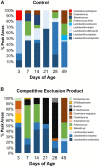Pioneer colonizers: Bacteria that alter the chicken intestinal morphology and development of the microbiota
- PMID: 37064908
- PMCID: PMC10090334
- DOI: 10.3389/fphys.2023.1139321
Pioneer colonizers: Bacteria that alter the chicken intestinal morphology and development of the microbiota
Abstract
Microbes commonly administered to chickens facilitate development of a beneficial microbiome that improves gut function, feed conversion and reduces pathogen colonization. Competitive exclusion products, derived from the cecal contents of hens and shown to reduce Salmonella colonization in chicks, possess important pioneer-colonizing bacteria needed for proper intestinal development and animal growth. We hypothesized that inoculation of these pioneer-colonizing bacteria to day of hatch chicks would enhance the development of their intestinal anatomy and microbiome. A competitive exclusion product was administered to broiler chickens, in their drinking water, at day of hatch, and its impact on intestinal morphometrics, intestinal microbiome, and production parameters, was assessed relative to a control, no treatment group. 16S rRNA gene, terminal restriction fragment length polymorphism (T-RFLP) was used to assess ileal community composition. The competitive exclusion product, administered on day of hatch, increased villus height, villus height/width ratio and goblet cell production ∼1.25-fold and expression of enterocyte sugar transporters 1.25 to 1.5-fold in chickens at 3 days of age, compared to the control group. As a next step, chicks were inoculated with a defined formulation, containing Bacteroidia and Clostridia representing pioneer-colonizing bacteria of the two major bacterial phyla present in the competitive exclusion product. The defined formulation, containing both groups of bacteria, were shown, dependent on age, to improve villus height (jejunum: 1.14 to 1.46-fold; ileum: 1.17-fold), goblet cell numbers (ileum 1.32 to 2.51-fold), and feed efficiency (1.18-fold, day 1) while decreasing Lactobacillus ileal abundance by one-third to half in birds at 16 and 42 days of age, respectively; compared to the phosphate buffered saline treatment group. Therefore, specific probiotic formulations containing pioneer colonizing species can provide benefits in intestinal development, feed efficiency and body weight gain.
Keywords: anaerobes; feed efficiency; intestinal development; microbiome; performance.
Copyright © 2023 Lee, Pedroso, Lumpkins, Cho and Maurer.
Conflict of interest statement
The authors declare that the research was conducted in the absence of any commercial or financial relationships that could be construed as a potential conflict of interest.
Figures




Similar articles
-
Delayed access to feed early post-hatch affects the development and maturation of gastrointestinal tract microbiota in broiler chickens.BMC Microbiol. 2022 Aug 24;22(1):206. doi: 10.1186/s12866-022-02619-6. BMC Microbiol. 2022. PMID: 36002800 Free PMC article.
-
Enterococcus faecium PNC01 isolated from the intestinal mucosa of chicken as an alternative for antibiotics to reduce feed conversion rate in broiler chickens.Microb Cell Fact. 2021 Jun 28;20(1):122. doi: 10.1186/s12934-021-01609-z. Microb Cell Fact. 2021. PMID: 34182992 Free PMC article.
-
Evaluation of the impact of in ovo administered bacteria on microbiome of chicks through 10 days of age.Poult Sci. 2019 Nov 1;98(11):5949-5960. doi: 10.3382/ps/pez388. Poult Sci. 2019. PMID: 31298298
-
Bacillus subtilis delivery route: effect on growth performance, intestinal morphology, cecal short-chain fatty acid concentration, and cecal microbiota in broiler chickens.Poult Sci. 2021 Mar;100(3):100809. doi: 10.1016/j.psj.2020.10.063. Epub 2020 Nov 12. Poult Sci. 2021. PMID: 33518343 Free PMC article.
-
Principles of ex ovo competitive exclusion and in ovo administration of Lactobacillus reuteri.Poult Sci. 1997 Jan;76(1):179-96. doi: 10.1093/ps/76.1.179. Poult Sci. 1997. PMID: 9037704 Review.
Cited by
-
Comparative effects of vegetarian diet and rendered animal by-product on the chicken gut health.Poult Sci. 2025 Sep;104(9):105360. doi: 10.1016/j.psj.2025.105360. Epub 2025 May 29. Poult Sci. 2025. PMID: 40482531 Free PMC article.
-
Peeling back the many layers of competitive exclusion.Front Microbiol. 2024 Mar 21;15:1342887. doi: 10.3389/fmicb.2024.1342887. eCollection 2024. Front Microbiol. 2024. PMID: 38591029 Free PMC article.
-
Key findings from 15 years of Mangrovibacter research: a generalist bacterium beyond endophytes.Appl Environ Microbiol. 2025 Aug 20;91(8):e0247924. doi: 10.1128/aem.02479-24. Epub 2025 Jul 10. Appl Environ Microbiol. 2025. PMID: 40637407 Free PMC article. Review.
-
Isolation, molecular identification, and genomic analysis of Mangrovibacter phragmitis strain ASIOC01 from activated sludge harboring the bioremediation prowess of glycerol and organic pollutants in high-salinity.Front Microbiol. 2024 Jun 25;15:1415723. doi: 10.3389/fmicb.2024.1415723. eCollection 2024. Front Microbiol. 2024. PMID: 38983623 Free PMC article.
-
16S rRNA and transcriptome analysis revealed the regulatory mechanism of Romboutsia lituseburensis on serum immunoglobulin levels in geese.Poult Sci. 2025 May;104(5):105018. doi: 10.1016/j.psj.2025.105018. Epub 2025 Mar 10. Poult Sci. 2025. PMID: 40086254 Free PMC article.
References
-
- Abd El-Hack M. E., El-Saadony M. T., Saad A. M., Salem H. M., Ashry N. M., Abo Ghanima M. M., et al. (2022). Essential oils and their nanoemulsions as green alternatives to antibiotics in poultry nutrition: A comprehensive review. Poult. Sci. 101, 101584. 10.1016/j.psj.2021.101584 - DOI - PMC - PubMed
-
- Alagawany M., Elnesr S. S., Farag M. R., Tiwari R., Yatoo M. I., Karthik K., et al. (2020). Nutritional significance of amino acids, vitamins and minerals as nutraceuticals in poultry production and health - a comprehensive review. Vet. Q. 41, 1–29. 10.1080/01652176.2020.1857887 - DOI - PMC - PubMed
LinkOut - more resources
Full Text Sources
Molecular Biology Databases
Research Materials

